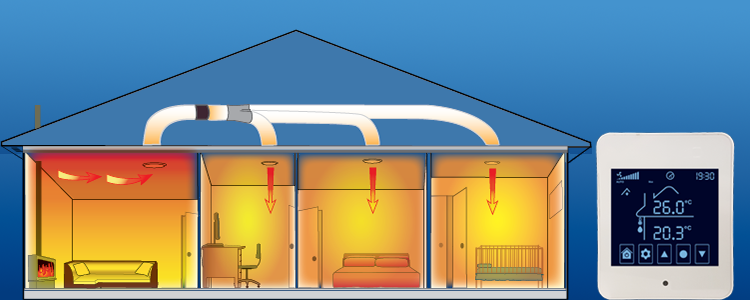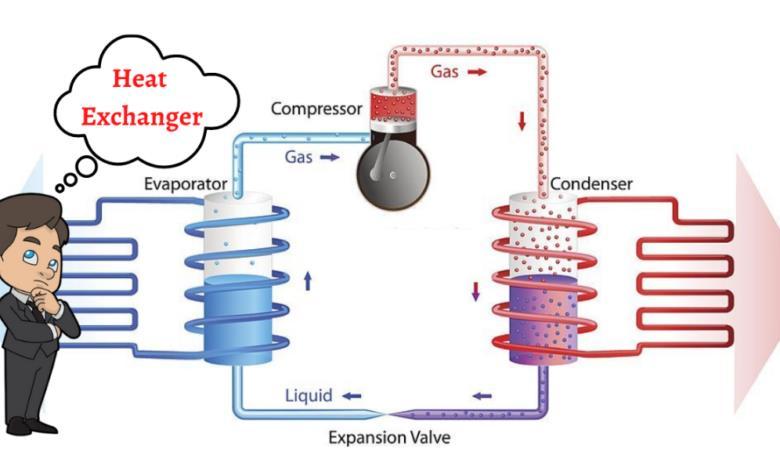A Comprehensive Overview to Picking the Right Heat Transfer Systems for Your Needs
Picking the suitable Heat transfer system is important for functional performance. Different systems accommodate various needs, influenced by variables such as temperature level array and fluid type. Comprehending the concepts behind Heat transfer, such as radiation, convection, and transmission, is critical. Additionally, reviewing energy resources and maintenance practices can affect long-term efficiency. A closer evaluation of these factors to consider reveals just how to tailor a system to certain demands. What should one prioritize in this complex decision-making process?
Recognizing Heat Transfer: Trick Concepts and Principles
Although Heat transfer might look like a simple idea, it incorporates a variety of principles that are essential for reliable system style. Comprehending these concepts is vital for developers and designers who aim to maximize thermal efficiency in various applications. Transmission, as an example, entails the transfer of Heat through solid materials, while convection refers to the motion of Heat within fluids. Radiation, one more crucial concept, explains how Heat can be transferred with electromagnetic waves. Each of these mechanisms plays an essential function in establishing just how power relocates within a system. By thoroughly grasping these principles, specialists can make informed decisions, making sure that Heat transfer systems run effectively and fulfill the specific needs of their applications
Kinds Of Heat Transfer Systems: An Overview
Recognizing the concepts of Heat transfer lays the foundation for checking out the numerous kinds of Heat transfer systems available. Heat transfer systems can be classified mainly right into 3 kinds: transmission, radiation, and convection. Conduction involves Heat transfer via solid materials, counting on direct get in touch with in between bits. Convection, on the other hand, occurs in fluids (gases and fluids) where the activity of the fluid itself assists in Heat transfer. Radiation includes the transfer of Heat with electromagnetic waves and does not call for a tool, enabling it to happen in a vacuum. Each kind of system has distinct features and applications, making it vital for individuals and organizations to meticulously assess their details demands when picking one of the most suitable Heat transfer option.
Applications of Heat Transfer Solutions in Numerous Industries
Heat transfer systems play a crucial duty throughout various sectors, affecting efficiency and product high quality. In industrial production processes, they help with accurate temperature level control, while in food and drink processing, they assure security and preservation. Additionally, HVAC and climate control systems rely heavily on efficient Heat transfer to keep comfortable atmospheres.
Industrial Production Processes

Many industrial production processes count greatly on effective Heat transfer systems to optimize performance and enhance item top quality. In fields such as metalworking, Heat exchangers play a crucial function in maintaining suitable temperature levels throughout welding, casting, and creating. These systems guarantee consistent Heat distribution, which is crucial for attaining wanted product residential or commercial properties. In a similar way, in the chemical production sector, Heat transfer systems promote exact temperature level control during reactions, impacting return and safety and security. In addition, in fabric manufacturing, effective Heat administration is essential for coloring and finishing processes, affecting shade consistency and material high quality. By choosing appropriate Heat transfer modern technologies, suppliers can enhance energy efficiency and reduce operational expenses, eventually causing a more competitive and sustainable production atmosphere.
Food and Beverage Processing
Reliable Heat transfer systems are equally important in the food and drink processing market, where keeping suitable temperature levels is crucial for food security and high quality. These systems play a vital duty in processes such as food preparation, pasteurization, and sterilization, making certain that products are secure for consumption and maintain their dietary worth. Heat exchangers, as an example, efficiently transfer Heat between fluids, optimizing power use while decreasing temperature changes. In addition, refrigeration systems are essential for preserving disposable products and expanding rack life. The choice of Heat transfer modern technology directly influences operational efficiency and item integrity, making it important for food and beverage suppliers to pick the appropriate systems blog here tailored to their details processing requirements. This mindful choice eventually contributes to consumer satisfaction and food security.

A/c and Environment Control
While lots of industries count on Heat transfer systems for effectiveness, A/C (Home Heating, Ventilation, and A/c) plays an essential function in preserving interior environment control across different setups. These systems make use of Heat transfer principles to regulate air, temperature, and humidity high quality, guaranteeing convenience and safety in property, business, and industrial environments. Properly developed cooling and heating systems improve power efficiency, minimize functional prices, and reduce environmental impact. In industrial structures, as an example, efficient climate control adds to employee efficiency and consumer fulfillment. In industrial applications, heating and cooling systems assist keep perfect problems for equipment operation and item conservation. Selecting the appropriate Heat transfer system is crucial for meeting certain climate control requirements and achieving overall system efficiency.
Reviewing Energy Sources for Heat Transfer Equipments
In reviewing power sources for Heat transfer systems, a comparison of sustainable energy options and fossil fuel factors to consider is vital. Sustainable sources, such as solar and wind, offer sustainable options that can decrease environmental influence. Alternatively, nonrenewable fuel sources stay common because of their recognized facilities and power thickness, triggering a mindful evaluation of both options.
Renewable Resource Options

Nonrenewable Fuel Source Factors To Consider
Assessing nonrenewable fuel source considerations is essential for the performance and sustainability of Heat transfer systems. Nonrenewable fuel sources, such as natural gas, oil, and coal, are conventional energy resources that provide substantial Heat result, making them popular choices for property and industrial applications. Their environmental influence, consisting of greenhouse gas emissions and resource exhaustion, elevates worries. When picking a heat transfer system, it is important to assess the availability, cost, and governing factors connected with these fuels. Furthermore, the performance of fossil gas systems must be taken into consideration, as greater efficiency can minimize some ecological drawbacks. Inevitably, a balanced method weighing efficiency and sustainability can assist decision-makers toward one of the most appropriate Heat transfer remedy for their certain needs.
Elements to Think About When Picking a Warm Transfer System
Selecting a proper Heat transfer system requires careful consideration of different factors that can significantly affect effectiveness and performance. One crucial variable is the operating temperature level array, which dictates the products and style appropriate for the application. In addition, the kind of liquid made use of in the system-- whether gas or liquid-- impacts Heat transfer efficiency and compatibility. The system's dimension and capacity need to straighten with the particular needs of the operation to avoid inadequacies. Power resource schedule is likewise crucial, influencing operating expenses and sustainability. Additionally, the setup environment, consisting of area restrictions and availability for maintenance, plays a significant role in system option. Regulative compliance and safety standards have to be taken into consideration to guarantee the system fulfills all legal requirements.
Maintenance and Performance Optimization for Heat Transfer Equipments
Maintaining Heat transfer systems is vital for ensuring optimal effectiveness and longevity. Routine upkeep tasks, such as cleaning Heat exchangers and examining insulation, aid stop effectiveness losses because of fouling and thermal linking. Furthermore, keeping an eye on system parameters, consisting of pressure and temperature level, enables early discovery of anomalies, decreasing downtime and expensive fixings. Executing a preventative maintenance routine can maximize performance and prolong the life-span of components. Updating to advanced control systems can improve operational effectiveness by readjusting to differing problems and loads. By focusing on maintenance and efficiency optimization, drivers can achieve decreased power intake, reduced functional prices, and boosted overall system integrity, ultimately bring about much better resource usage and a much more sustainable procedure.
Future Trends in Heat Transfer Technologies
As markets significantly prioritize sustainability and power effectiveness, future patterns in Heat transfer modern technologies are established to undergo considerable changes. Developments such as advanced materials, including carbon nanotubes and nanofluids, promise enhanced thermal conductivity and performance. In addition, the assimilation of sustainable energy sources into Heat transfer systems is getting momentum, promoting environment-friendly services. Smart innovations, including IoT sensing units, are anticipated to reinvent tracking and control, allowing real-time data evaluation for optimized efficiency. Moreover, the development of modular and compact systems will promote less complicated installment and upkeep, providing to varied applications. These advancements show a change towards even more lasting, efficient, and versatile Heat transfer solutions, aligning with global power objectives and environmental standards.
Regularly Asked Questions
What Are the Ecological Effects of Heat Transfer Systems?
The ecological influences of Heat transfer systems can include greenhouse gas emissions, power usage, and prospective thermal pollution. Furthermore, improper disposal of ineffectiveness and products can add to resource exhaustion and environment disruption.
Exactly how Do I Compute the Cost-Effectiveness of a Heat Transfer System?
To determine the cost-effectiveness of a heat transfer system, one have to examine first costs, operational costs, upkeep needs, and power performance, comparing these variables against the expected life expectancy and performance of the system.
Can Heat Transfer Equipment Be Utilized in Residential Setups?
Heat transfer systems can official website undoubtedly be utilized in household settings. They provide reliable heating and cooling down solutions, making homes more comfy while potentially decreasing energy expenses. Their convenience permits numerous applications in household environments.
What Safety Laws Apply to Heat Transfer Equipments?
Security laws for Heat transfer systems usually consist of guidelines on upkeep, installment, and procedure. Compliance with local building regulations, manufacturer Resources specifications, and industry criteria is vital to ensure risk-free and reliable system efficiency in numerous applications.
How Do Different Materials Affect Heat Transfer Efficiency?

Conduction, for circumstances, involves the transfer of Heat through strong products, while convection refers to the activity of Heat within liquids. Recognizing the concepts of Heat transfer lays the foundation for discovering the numerous kinds of Heat transfer systems offered. Heat exchangers, for instance, efficiently move Heat in between liquids, maximizing energy usage while lessening temperature level variations. In reviewing power resources for Heat transfer systems, a contrast of sustainable energy options and fossil fuel factors to consider is vital. Metals, such as copper and light weight aluminum, conduct Heat successfully, whereas insulators like rubber and glass reduce down Heat flow.